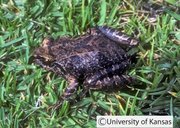|
Description
The head is as wide as or narrower than body and wider than long. The snout is subacuminate in dorsal view and rounded when viewed laterally. The nostrils are weakly protuberant and directed dorsolaterally. The canthus rostralis is angular and weakly concave. The loreal region is slightly concave and slopes abruptly to the lips that are not flared. The upper eyelid is smooth and/or possesses small and low tubercles. Cranial crests are low and evident only in females. The supratympanic fold is swollen and obscures the upper edge of the tympanic annulus. Choanae are small and round, not concealed by the palatal shelf of the maxillary arch. The vomerine odontophores are triangular and elevated while being longer than the choanae (they are separated medially by a distance equal to the width of the odontophore; each bears 3 to 5 teeth). Dorsal skin is finely shagreen with some slightly larger warts that are evident on the dorsum postsacrally and indistinct dorsolateral folds made up of low warts. Skin on throat is wrinkled while skin on venter is areolate. The upper surfaces of the arms are smooth. Thenar tubercle is oval and much smaller than the bifid palmar tubercle. Fingers possess fringes; the first finger is shorter than the second and the thumb lacks an expanded disc. Discs on fingers II-IV are approximately 1.5 times the width of the digits. The toes possess prominent lateral keels; webbing on toes absent. All toes have discs that are slightly smaller than those on the outer fingers. In life, the coloration is a brown dorsal coloration with dark brown chevrons on the body and transverse bars on the limbs narrowly bordered by orange-tan. The flanks are a dull brown with irregular dark brown vertical marks with many small tan flecks ventrally. The iris is brown and has a dull bronze ring around the pupil. Pristimantis truebae is most similar to P. vertebralis but the two are distinguished by the latter having an obvious tympanic membrane. Another character is that the dorsal surfaces of the digital discs are black in P. vertebralis where they are the same as the dorsal color in P. truebae. In life, the iris is brown in P. truebae where it is red (or copper) in P. vertebralis. Distribution and Habitat
Country distribution from AmphibiaWeb's database: Ecuador
Specimens were collected in elevations ranging from 2870-3190 m at the upper edge of the humid montane forests on the western slopes of the Andes in Provincias Bolivar, Canar, and Cotopaxi in Ecuador. Life History, Abundance, Activity, and Special Behaviors
All specimens were collected under rocks by day in disturbed areas in the upper humid montane forest. Possible reasons for amphibian decline General habitat alteration and loss
References
Lynch, J. D. and Duellman, W.E. (1997). Frogs of the Genus Eleutherodactylus in Western Ecuador. The University of Kansas Natural History Museum, Lawrence, Kansas.
Originally submitted by: Raul E. Diaz (first posted 2004-12-14)
Edited by: Kellie Whittaker (2007-12-01)Species Account Citation: AmphibiaWeb 2007 Pristimantis truebae <https://amphibiaweb.org/species/5596> University of California, Berkeley, CA, USA. Accessed May 30, 2025.
Feedback or comments about this page.
Citation: AmphibiaWeb. 2025. <https://amphibiaweb.org> University of California, Berkeley, CA, USA. Accessed 30 May 2025.
AmphibiaWeb's policy on data use.
| 



 Map of Life
Map of Life